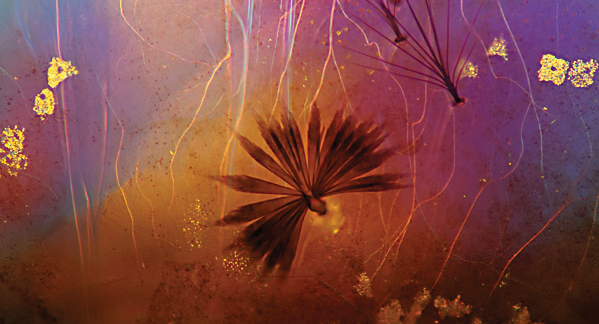Photomicrography
March 18, 2019

An amorphous burst of color flashes across an alien landscape. Vibrant shades splash about while distinct lines bring patterns into focus. This vitality of colors, patterns and strangely familiar designs is only observable through the lens of a microscope. There is more to nature than what meets the naked eye, and simply magnifying one’s perspective reveals an otherworldly beauty in butterfly wings, the shells of crustaceans or even just the bubbles in alcohol. With improving digital technology and an expanding interest in the microworld, scientists and artists alike are exploring the allure of the natural world through photomicrography, the practice of taking photos of samples from different crevices of nature through a microscope.
Before the rise of digital photography, photomicrography was considered a highly specialized skill that required years of training, and it was often only used in research contexts.
However, this quickly began to change as new technology developed to allow both professionals and hobbyists to take microscope photos. As avid supporters of photomicrography, Nikon Instruments contributed to this field by producing a multitude of different products, ranging from microscopes to software. To further promote the importance of the connection between art and science, Nikon established the Nikon International Small World Competition in 1975. The competition first began with the purpose to recognize beautiful images taken through microscopes and to showcase the work of photomicrographers from all around the world. Since then, winning photographs have been displayed in famous museums and on the covers of prestigious scientific journals.
Nikon’s Small World Competition is an international gathering of photomicrography enthusiasts. To Nikon Instruments’ communications manager Eric Flem, the competition also opens the doors to the public. “The expression of science through art helps provide a window for the public to see what the scientific community sees every day in their journey of discovery,” he said. “Much of scientific research is funded by the public, and a better broad understanding of things scientific is sure to have a positive effect.” By displaying the inner world of science through art, such as photomicrographs, science becomes more easily accessible and understandable for the public.
Photographer Marek Miś from Poland has devoted himself to taking micrographs since 2009. Facing difficulties in the 1980s with cumbersome technology and materials, Miś revived his passion when digital photography was made readily accessible. Miś has been a finalist in many competitions devoted to microphotography, and a wide variety of his photos have been featured on publication covers and in galleries.
“Photomicrography is a special type of photography because I can show what is completely invisible to most people,” Miś said. “It allows others, even for a moment, to enter a completely different world accessible only to people equipped with microscopes.”
Miś believes that anyone can appreciate the beauty of the natural world and should not feel limited by a lacking background or knowledge in science. “Photomicrography can amaze and at the same time delight with the beauty of nature,” Miś said. “You do not have to be a scientist to get inspiration from the micro world.” There are many instances where science is employed as a tool to craft art but in the case of photomicrography, art is used as a conduit to reveal the beauty within science.
In order to shift awareness from the macroworld to the microworld, photomicrographers use their artwork to reveal hidden portions of nature. “The natural world is so much more than what we see with our eyes,” Flem said. “The systems and series of events that have come to manifest what we are seeing are so complex. In the case of photomicrography, we simply employ tools that allow us to see what we physically cannot see otherwise.”
With photomicrography at the crossroads of science and art, this fast-growing genre of art has great potential. “Without science, there is no art and without art, there is no science,” Flem said. “Art and science are two sides of the same coin and by recognizing this, we only stand to gain in both realms.”
The casual viewer can observe the beauty in nature almost every day. From the elegance of math formulas to the magnificence of the tallest tree, millennia of human civilizations have always drawn from nature as a muse. As technology and scientific advances bridge the gap between the observable and the invisible, new ways to be amazed by the beauty of the natural world are constantly found.